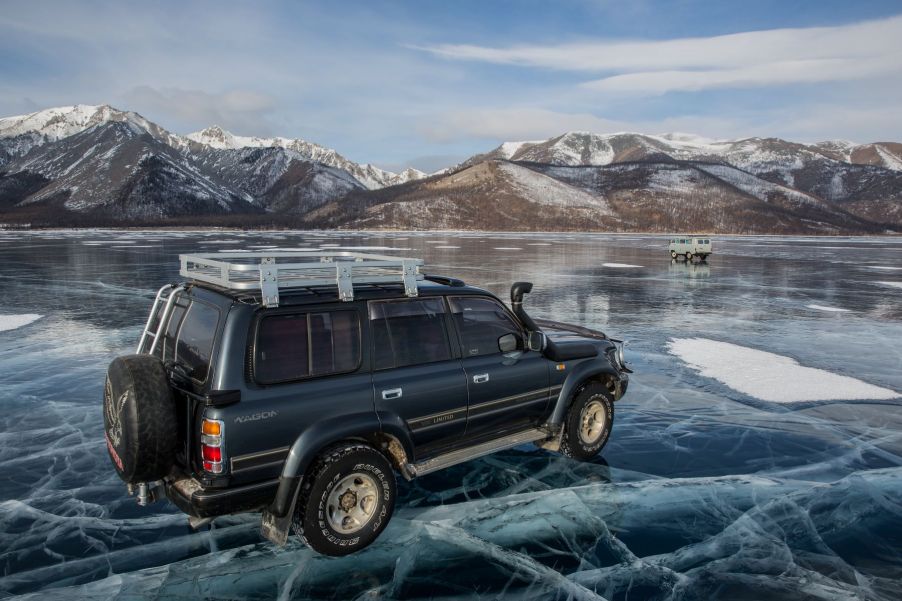
How to Safely Drive a Car or Truck Over a Frozen Lake
During winter, motorists use vehicles to travel over frozen lakes as a mode of transport, which is a mission that can turn out fatal. Some people have traveled on ice for the longest time, like the Alaskans and Canadians in the far north. Some do it as part of winter recreation, such as ice fishing, while others traverse frozen lakes as the only way to reach islands surrounded by ice. Cars traveling on ice is not a very wise idea in terms of car safety, so it’s better to gain knowledge than end up losing your life, your loved ones, and your car.
According to Boreal, traveling on frozen lakes or rivers is more dangerous than you think. While ice is never completely safe to travel over, the additional knowledge you have, the less likely your vehicle will encounter problems—or your life.
How thick should ice be when driving on it?

Some people think that ice is thick enough to drive on just because it’s cold outside. However, solid ice should be 12-15 inches wide to consider it safe to drive a truck over and 8 inches or more for an average passenger vehicle. Additionally, the ice thickness shouldn’t be less than 5 inches when using a snowmobile. According to WQAD, the thickness should be at least 4 inches for fishing or just a walk, as anything less is unsafe.
Many lakes freeze solid enough to drive on throughout the winter, but critical safety precautions should be adhered to. Always test the surface before driving on it and apply the rule that you should not navigate on less than 6 inches of ice. A single inch of beautiful clear ice should be present per one thousand pounds of body weight, so know the heaviness of your car and its contents. If you’re parked, double the number, and you should “punch a hole beside the vehicle and keep an eye out for water welling up,” as this indicates that the ice is flowing downward.
Safety tips for driving on top of a frozen lake
1. Safety guidelines from Alberta workplace health state vehicles should be 100 times the minimum suitable ice thickness. For example, if ice thickness is 200mm, the distance between cars should be at least 200 meters apart. So keep your distance and be on the lookout. If you are in a convoy, always be first.
2. Has it crossed your mind that driving faster is safer on the lake since you will get away from falling ice? Moving faster is more dangerous because it puts pressure on the ice, leading to a fracture, worsening everything. Drive 30km/h (18 to 19 mph) on ice with water and 15km/h (9 to 10 mph) toward the shore or drive parallel to the beach.
3. Before starting your journey, it is advisable to check on your tires. Bald tires will cause danger. Use a penny to check your tire depth gauge; insert the penny in the tire tread, and if you see Lincoln’s head, do away with it. Snow tires or all-season tires are preferred more since they add friction between the tires and the lake. Other drivers put chains on the tires that give the tires a firmer grip on the road.
4. To be safe when driving on ice, make sure your windows are open so you can get a quick escape from a worst-case scenario. If you sink when the windows are closed, you will go down with your car. Those on snowmobiles should wear PFD inflatables, but not motorists, as these will make it difficult to escape from the cabin of a sinking car.
5. Use chainsaws to drill through the ice. Then use a ruler to measure ice thickness. Canadian road guidelines state if you are traveling on ice, be cautious and check thickness every 100 feet with lakes and 50 feet with rivers.
6. When you drive on ice, it bends and takes its original form after some time. This is different when you decide to park; it puts load pressure on ice that might break. Canadian ice guidelines say you should calculate ice at half its thickness when the car is parked. As the Minnesota DNR states, vehicles should be parked 50 feet or more apart, and you should move your vehicle every 2 hours.
7. For your safety’s sake, always carry extra warm clothing, portable heat sources, an extra battery, a mobile phone for communication, and snacks; you need to be prepared; the frozen lake might surprise you. It will help if you also have nebulous floatation if the unexpected happens.
Never drive with snow on your car
Hefty fines are imposed on people who drive with ice on the roof or windows of their vehicles.
In Delaware, Connecticut, Missouri, and Massachusetts, you’ll be fined between 75-1000 dollars if you drive with ice or snow in your car since it’s considered illegal and dangerous, according to the Weather Tips Guide. Elsewhere, some states like Illinois, Alaska, and New York prohibit driving vehicles with obstructing objects on your car’s windscreens.
Before driving, clear the ice and snow from your car by following the tips.
- Brush with a snow broom that’s soft so as not to remove the paint on your car.
- Cover the top of your vehicle with a heavy tarp and remove it when you need to use your vehicle.
- Place covers over your windows when the car is parked, and remove them and warm your car before moving.


